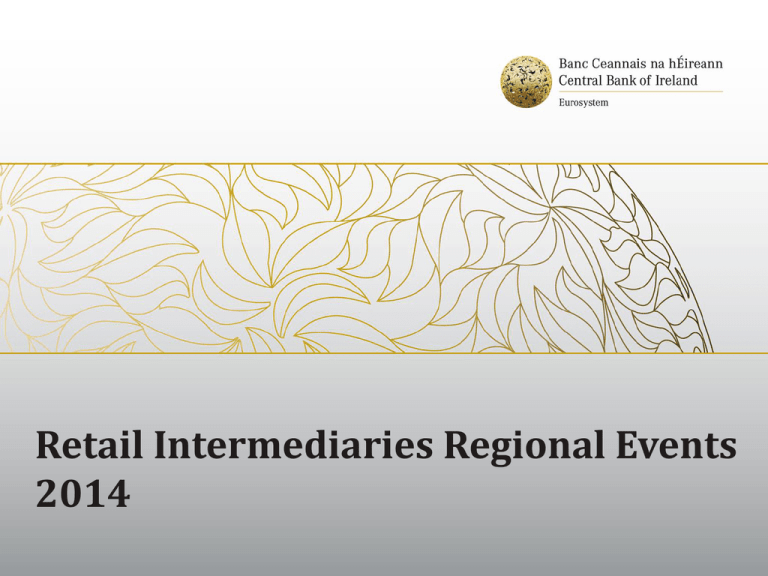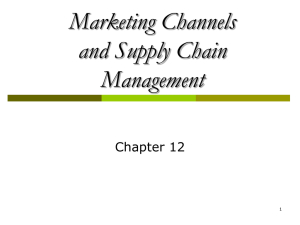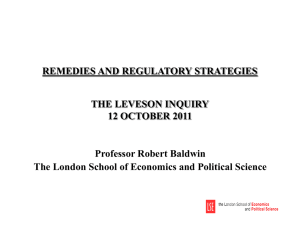Assessment & Monitoring Work stream (Top 7 lenders): Milestones
advertisement

Retail Intermediaries Regional Events 2014 Pensions Themed Inspection • Central Bank disappointed with the level of compliance shown • Issues arose with over half of the files reviewed, with a pattern of issues emerging • Central Bank’s view is that an intermediary should be able to evidence/demonstrate compliance with the Code • In a number of cases intermediaries did not hold relevant information on file at the time of the inspection • Firms provided redress to consumers where relevant 2 Pensions Themed Inspection – Next Steps • Follow up with individual firms to rectify issues to ensure that the best outcome is achieved for the consumer • Results of the review will be published in a Special edition Intermediary Times • Further work to be considered: • Possible further inspections • Further work with relevant firms • Discussions with Product Providers in relation to commission options available to intermediaries 3 Handbook of Prudential Requirements for Investment Intermediaries • Change to definition of firm types • Requirement to hold Professional Indemnity Insurance • Requirement to notify the Central Bank when outsourcing any important operational function • Changes to regulatory reporting requirements • Firms required to be in a position to meet their debts as they fall due • Treatment of Goodwill and other Intangible Assets • Requirement to submit Annual Return via Online reporting system 4 Advertising monitoring common case issues • 4.10 regulatory disclosure statement • 9.2 (ad) clear, fair, accurate and not misleading • 4.1 (info) should be clear, accurate and up to date • 9.6 key information • 9.7 qualifying criteria • 4.7 regulatory disclosure use Fees and Charges • Make full disclosure of all relevant information, to include charges • NB: A regulated entity must display in its public offices, in a manner that is easily accessible to consumers, a schedule of fees and charges imposed by that regulated entity. If the regulated entity has a website, its schedule of fees and charges must also be made publicly available through placing this schedule on its website. 6 The Central Bank’s enforcement role ‘Enforcement’ Powers of the Central Bank of Ireland • The Central Bank’s ‘enforcement’ powers: – administrative sanctions; – fitness and probity regime; – revocation and refusal of licences; – summary criminal prosecution. • Also, reports to other agencies (e.g. Gardaí, Revenue Commissioners, Competition Authority) 8 Who might face enforcement action? • Regulated Financial Service Providers, including: – Intermediaries; – Credit Institutions; – Insurers; – Investment Firms; – Stockbrokers; – Licenced Moneylenders; – Credit Unions • Those concerned in the management of a regulated financial service provider. 9 What is an Administrative Sanctions Procedure (ASP)? • Most visible aspect of the Central Bank’s enforcement actions. • Investigation into whether a regulated entity has failed to comply with relevant: – Legal obligations imposed by statute or statutory instrument e.g. Consumer Credit Act, 1995, The European Communities (Insurance Mediation) Regulations, 2005; – Code of Conduct e.g. Consumer Protection Code; and – A direction by the Central Bank. 10 Public Enforcement Actions and Penalties (2006 – 2014) Number of Settlements Total Monetary Sanctions 18 9000000 16 8000000 14 7000000 12 6000000 10 5000000 8 4000000 6 3000000 4 2000000 2 1000000 0 2006 2007 2008 2009 2010 2011 2012 2013 2014 86 Settlement Agreements 11 0 2006 2007 2008 2009 2010 2011 2012 2013 €31,324,765 in fines 2014 Flow Diagram of Investigations Information relating to a suspected prescribed contravention Commencement of an Investigation Supervisory Warning Investigation Letter(s) Replies / Submissions Criminal Prosecution Supervisory Warning No Further Action Settlement Procedure Notice of Inquiry Inquiry 12 The ASP Settlement Process and Settlement Meetings • Voluntary process. • Is run in parallel to the Investigation/Inquiry. • Full information to be provided by regulated entity in response to any questions raised in Investigation Letters. • Settlement is conducted in private. • Settlement conducted on a “without prejudice” basis. • Only one settlement meeting. 13 Settlement Meeting – On the Day • Introduction by Central Bank. • Central Bank sets out facts of case, legal issues and any preliminary issues. • Central Bank sets out seriousness and proposed terms of settlement. • Reply from regulated entity. • Agreement in principle. • Publicity statement. • Aim is to agree: – settlement agreement; and – publicity statement. 14 Publicity Statements • Contains: – name of the regulated entity; – the prescribed contraventions; – the facts of the case (including relevant background); – the sanctions imposed, including any discount; – any mitigating factors; – any aggravating factors; and – an industry message. 15 Enforcement Priorities for 2014 Banking & Insurance Credit Unions • Prudential requirements • Prudential requirements (with a focus on reserves, liquidity, lending & investments) • Systems & controls • Timeliness and accuracy of information submitted to the Central Bank • Systems & controls • Governance Markets • Prudential requirements (with a focus on large exposures) • MiFID conduct of business rules • Client Asset Requirements • Timeliness and accuracy of information submitted to the Central Bank • Systems & controls Consumer Protection • Code of Conduct for Mortgage Arrears • Prudential requirements for retail intermediaries and debt management firms • Professional indemnity insurance • Firms which fail to engage appropriately with the Central Bank All Sectors 16 • Fitness and probity obligations of the Central Bank Reform Act 2010 • Anti-Money Laundering (AML)/Counter Terrorism Financing (CTF) compliance Developments – Legislation • Central Bank (Supervision and Enforcement) Act, 2013 – amendments to authorised officer powers and information gathering powers. – 3rd party reviews. – protected disclosure / whistle-blower regime. – restitution orders. – amendments to Part IIIC of the Central Bank Act 1942 • penalties of suspension and revocation of authorisations • increased monetary sanctions • offences of failing to comply 17 Industry Funding Levy Karen O’Leary, Industry Funding Manager November 2014 Introduction • Purpose • Levy in place since 2004 • Enabling legislation: Central Bank Reform Act, 2010 • Industry Funding Regulations: made on an annual basis by means of a Statutory Instrument • Funding arrangements: under review by Dept of Finance Basis for Calculation of Levy • Revised calculation methodology introduced in 2013 • Retail intermediaries fall into low impact category • Levies payable by Retail Intermediaries are determined with regard to the firm’s impact score under PRISM • In 2014, there were 7 bands and Industry Funding levies varied between €515 and €26,500 How is Impact Score Calculated • Determined by application of a model to certain key information provided as part of the firm’s OnLine Regulatory Return (ONR), namely - Turnover - Number of Retail Clients - Number of Customer Facing Advisors Default levies • Issued to those RIs who do not have an impact score because they failed to complete their ONR • Default levies are cancelled and replaced with an actual invoice following submission of the ONR Payment Methodologies • Electronic Funds Transfer • Direct Debit – single/recurring • Impact of E-Day Further Questions • Guide to Industry Funding Levy/FAQ which are published on our website • Helpline : 01-2244022 • Email : funding@centralbank.ie Thank you








